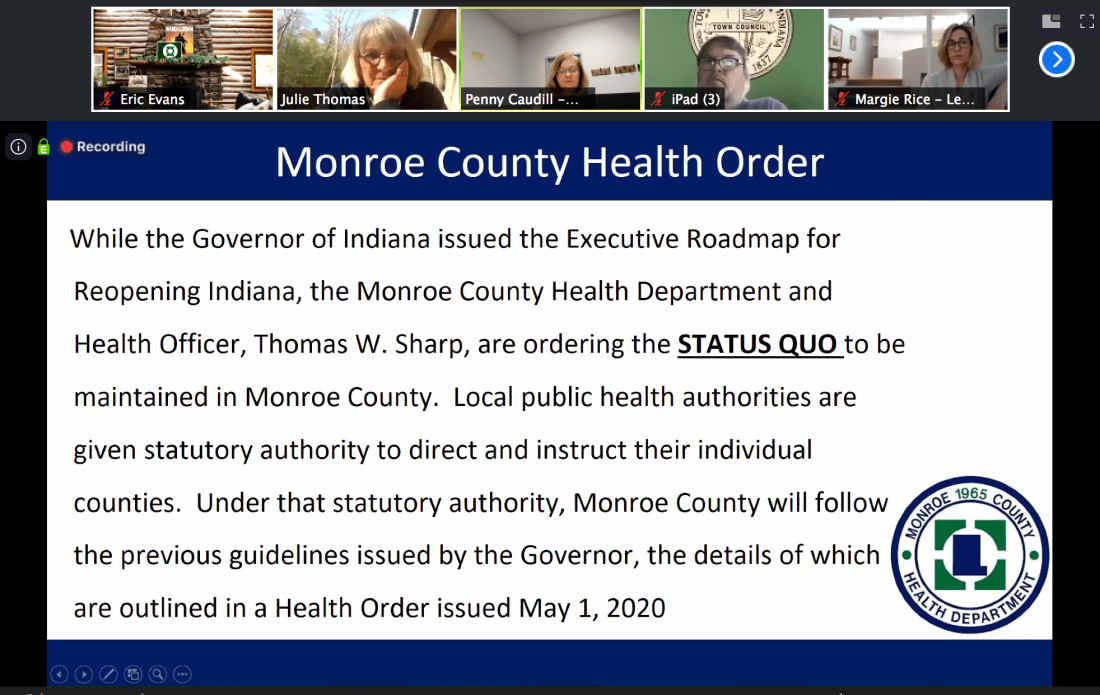Monroe goes slow: COVID-19 measures stay in place for two more weeks, as other parts of the state start opening on May 4

 In a COVID-19 public health order signed by Monroe County’s health officer Thomas Sharp on Friday, a stay-at-home directive was put in place for Monroe County’s residents that lasts until May 15.
In a COVID-19 public health order signed by Monroe County’s health officer Thomas Sharp on Friday, a stay-at-home directive was put in place for Monroe County’s residents that lasts until May 15.
Other features of Friday’s Monroe County order include a prohibition on restaurant dine-in service.
That means for another two weeks, life for Monroe County’s residents will look the same as it has under Indiana governor Eric Holcomb’s stay-at-home order over the last month and a half.
So Monroe County will be going slower than most of the rest of the state, based on Indiana governor Eric Holcomb’s revised order, issued earlier in the afternoon on Friday.
Holcomb’s order starts a phased-in approach, which for most of the state will see all retail stores allowed to open on Monday, May 4. But they can open at just 50 percent of their occupational capacity. Under Holcomb’s order, on May 11 restaurants would be allowed to open for dine-in service at 50 percent of their seating capacity. The governor’s order includes a series of phases that lead to a mostly complete re-opening by July 4.
Exceptions to that initial time frame in the governor’s order are for Marion, Lake and Cass Counties.
The governor’s order also makes explicit that local governments can impose stricter regulations than those included in the statewide order: “Nothing in this Executive Order shall, in any way, alter or modify any existing legal authority allowing the State, any local health department… any closure of a specific location for a limited period of time, including the duration of this public health emergency.”
Monroe County’s announcement that it would exercise its local health department option to stand pat for a while came at a resumed meeting of the county commissioners, conducted by Zoom video conference at 5:30 p.m.
Public health administrator Penny Caudill laid out the reason for Monroe’s go-slower approach. It’s based on the the failure of Monroe County to hit federal government “gating criteria” which include robust testing and contact tracing.
In Monroe county, other gating criteria, like a downward trajectory of cases, and the ability to treat all patients look like they’re met.
Caudill pointed out that by mid-May enhanced testing would be provided in Monroe County by OptumServe Health Services—as many as 132 tests a day. Up to now, Monroe County has ranged between 30 and 60 tests a day for a total of 1,233 tests done since the COVID-19 pandemic arrived in Indiana.
Also available in mid-May, Caudill said, would be support from a partnership the state has announced with Maximus, to centralize contact tracing and investigations. It includes the hire of 500 people and setting up a call center. Contact tracing is key to curbing the spread of the virus, because it ensures that people who’ve been in contact with people who tested positive are notified, so they can isolate themselves.
Assuming the number of cases has not reversed its downward trend, by mid-May the enhanced testing capability could put Monroe County on a path to re-opening. Caudill said the her department would continue to monitor the situation. She held out the possibility that Monroe County could eventually join the governor’s timeline instead of maintaining a separate timetable into the indefinite future.
At Friday’s meeting, Bloomington mayor John Hamilton expressed his support for the continuation of the status quo, pointing out that under Holcomb’s order, already on Monday next week, gatherings of 25 people would be allowed. Hamilton said that size gathering wasn’t yet appropriate.
Also expressing support for Monroe County decision on Frida was Brian Shockney , who’s president of IU Health’s South Central Region.
At Friday’s continued meeting, commissioner Julie Thomas got confirmation from county attorney Jeff Cockerill about the continuation of the county’s COVID-19 business relief program. The program uses the county’s food and beverage tax proceeds program to give relief to tourism-related businesses that have been impacted by the COVID-19 pandemic.
One of the governor’s Friday orders extended the health emergency to June 4, Cockerill said. That means the use of food and beverage tax funds for COVID-19 relief could continue, based on State Board of Accounts guidance.
On Wednesday, county commissioners made COVID-19 business grant awards that brought the total to about $160,000.
At their Friday 3 p.m. continuation of the Wednesday meeting, the county commissioners added another $4,462 to the total, with an award to TJV Balloons, Inc. The grants so far have come from an initial $200,000 appropriation of food and beverage tax proceeds.
Commissioners will be asking the food and beverage tax advisory commission (FABTAC) to recommend another $200,000. FABTAC has scheduled a meeting to consider the request on May 5 at 3:15 p.m.




Comments ()